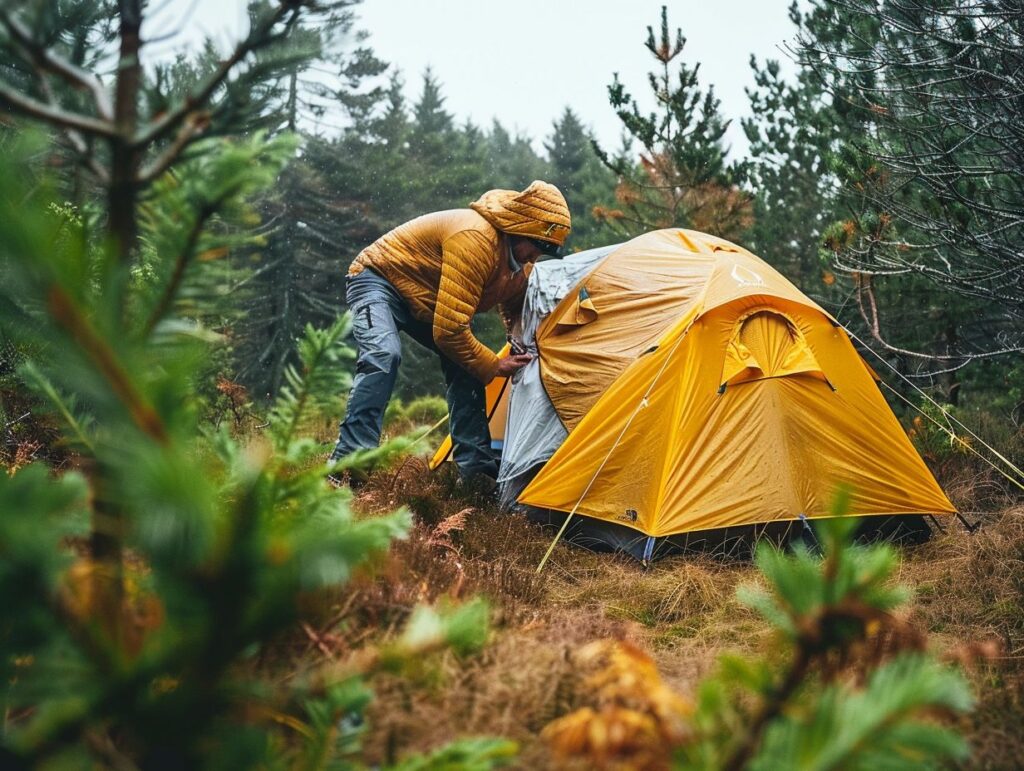Camping in windy conditions can pose unique challenges and potential dangers that campers must be prepared for. From securing your tent to staying safe and comfortable, there are essential tips and safety measures to take into consideration.
We will discuss how to prepare for camping in windy conditions, the best campsites for windy conditions, tips for cooking and sleeping, as well as how to pack up and leave a campsite safely.
Get expert advice on making the most of your windy camping adventure!
Key Takeaways:
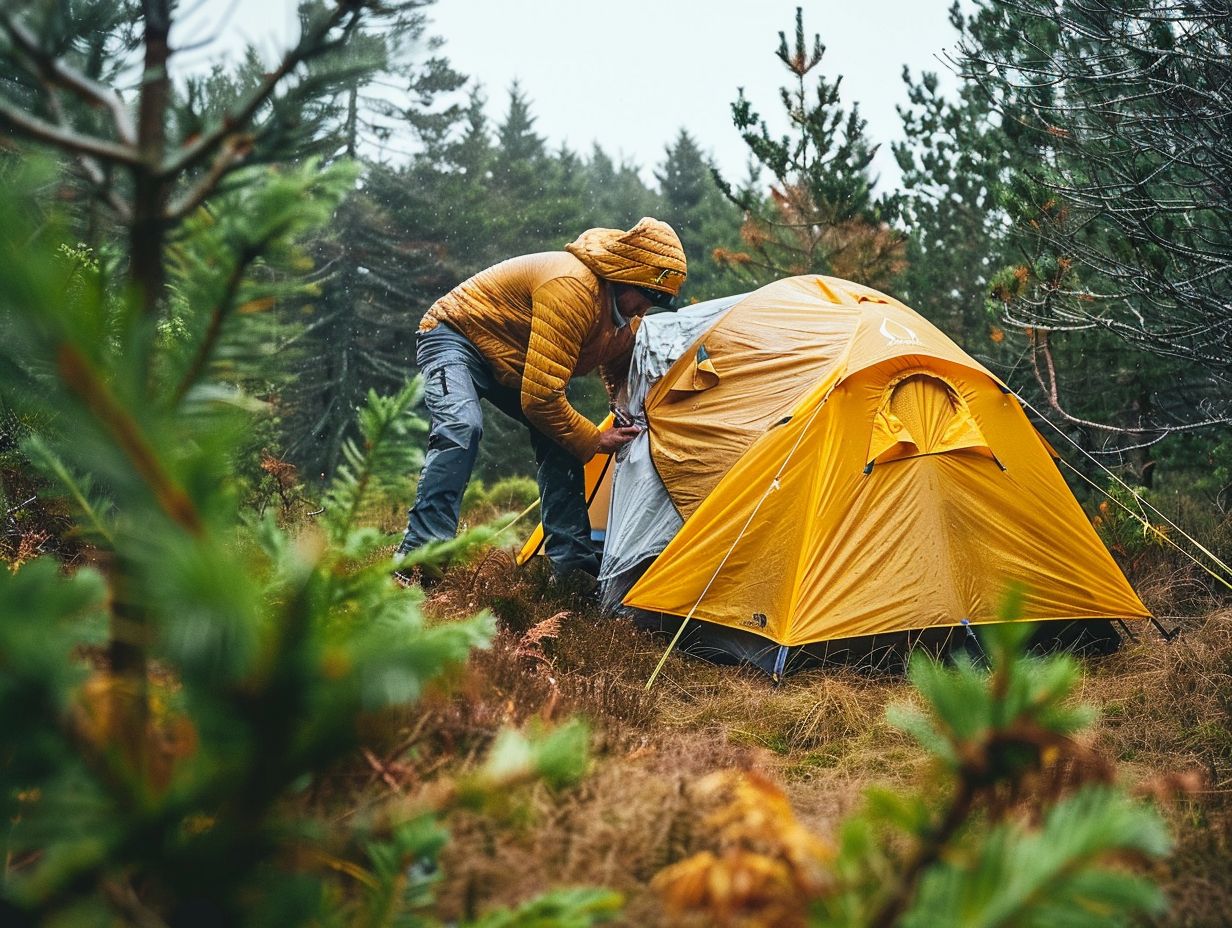
- Prepare for potential dangers and secure your tent in windy conditions to ensure safety.
- Choose a good campsite with wind-resistant features for a comfortable camping experience.
- Protect your fire, stay hydrated and engage in wind-friendly activities to enjoy camping in windy conditions.
How to Prepare for Camping in Windy Conditions?
When planning for camping in windy conditions, it is crucial to choose high-quality gear specifically designed to endure strong winds, such as resilient tents and durable pegs.
What Are the Essential Items to Pack for Camping in Windy Conditions?
When faced with camping in windy conditions, it is imperative to include essential items in your packing list. These items should include a reliable tent repair kit, high-quality pegs, and durable guy lines to maintain the security and stability of your shelter.
The tent repair kit is a crucial component as it enables swift and effective repairs of any tears or damages sustained by the tent due to strong winds. This ensures that the occupants remain dry and protected within the shelter. Quality pegs are essential for firmly anchoring the tent to the ground, thereby preventing it from being displaced by strong winds.
Additionally, sturdy guy lines play a pivotal role in enhancing the stability of the tent structure, particularly in gusty conditions. They help in distributing the external force and contribute to the overall resilience of the shelter.
The combined use of these essential items serves to enhance safety and comfort levels during outdoor camping activities in windy conditions.
How to Secure Your Tent in Windy Conditions?
Ensuring the stability of your tent in windy conditions entails the utilisation of high-quality pegs and stakes, coupled with the proper tensioning and anchoring of all guy ropes.
To effectively stake down and secure your tent, the initial step is to select a flat and level campsite. It is advisable to avoid locations susceptible to flooding or characterised by loose soil that may compromise the stability of the stakes. Once a suitable spot has been identified, proceed to position the tent on the ground and secure the corners first by staking them down.
It is imperative that the stakes are driven into the ground at a 45-degree angle away from the tent, employing a hammer or mallet if required. Subsequently, attach the guy ropes to the tent and stake them out at an angle, ensuring they are tensioned appropriately without being excessively tight to allow for some degree of flexibility in the face of windy conditions.
What Are the Safety Measures to Take During Camping in Windy Conditions?
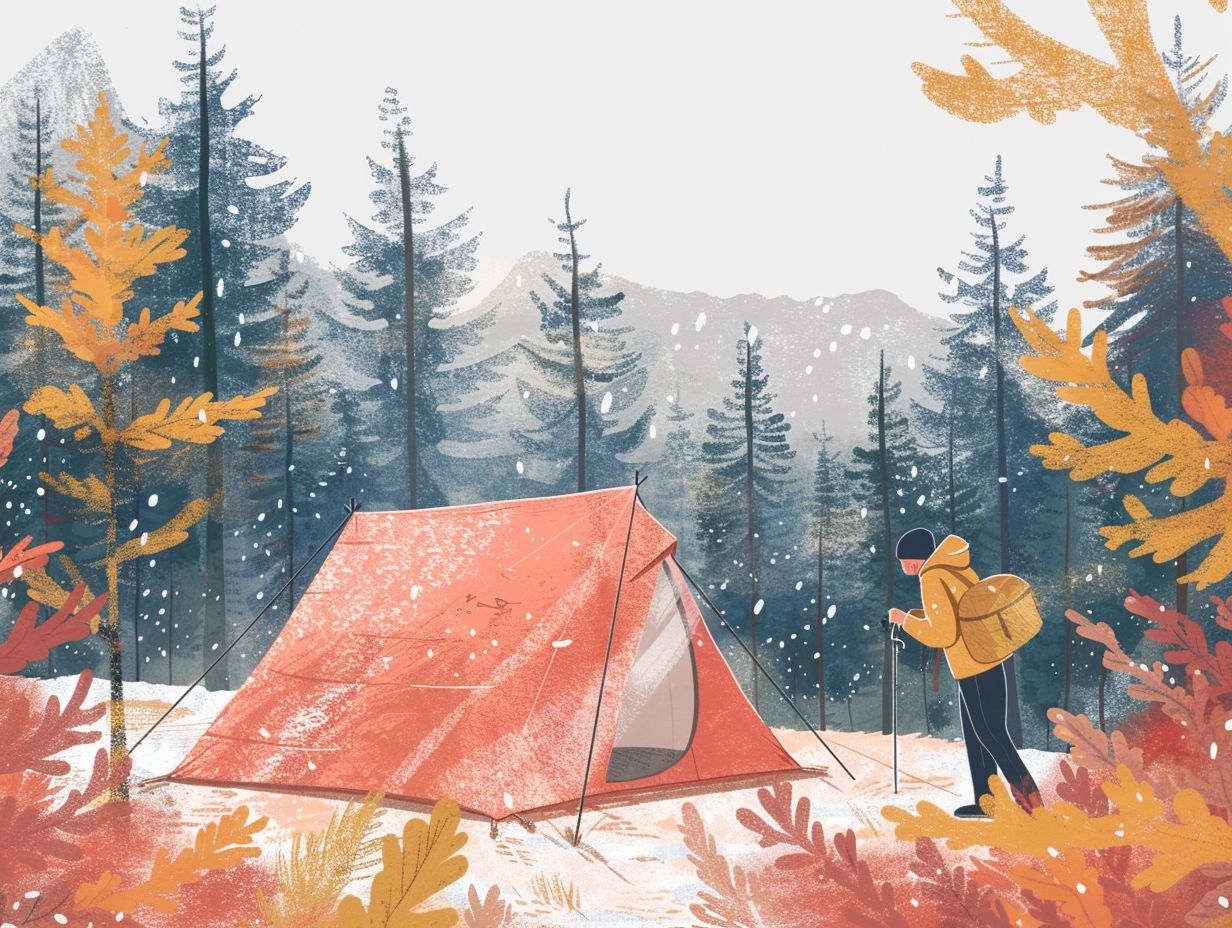
Precautionary measures to be observed during camping in windy conditions include the regular assessment of your tent’s stability, avoidance of camping under trees, and the securing of all loose objects.
When determining a campsite, it is advisable to seek locations shielded from strong winds, such as natural windbreaks or geographical features. Ensuring that your tent is adequately anchored and considering the use of guy lines for additional support is essential.
Remaining informed about weather forecasts enables you to anticipate potential abrupt shifts and take suitable precautions. It is imperative to vigilantly monitor your camping gear, fastening items like cooking utensils and chairs that are susceptible to being carried away by the wind.
By exercising vigilance and adopting a proactive approach, a safe and pleasant camping experience can be ensured even in blustery conditions.
What Are the Best Campsites for Windy Conditions?
Choosing ideal campsites for windy conditions involves selecting locations that offer natural windbreaks and are recognised for stable weather patterns.
What Are the Features of a Good Campsite for Windy Conditions?
A suitable campsite for windy conditions should ideally include natural windbreaks such as trees or hills, along with a level and stable ground for tent pitching.
When selecting a campsite, it is essential to take into account the terrain characteristics. Opt for areas that are not susceptible to flooding and boast efficient drainage systems. Additionally, natural obstacles like substantial rocks or boulders can offer additional shielding against intense winds.
Moreover, the proximity of the campsite to weather shelters or emergency services is a key consideration in the event of unforeseen weather fluctuations. The availability of these facilities can significantly improve safety and the overall camping experience during windy conditions.
What Are Some Recommended Campsites for Windy Conditions?
Some recommended campsites in North America that are suitable for windy conditions are managed by Kampgrounds of America (KOA), which includes various types of locations such as KOA Journey, KOA Holiday, and KOA Resort.
For example, KOA Journey in Barstow, California, is renowned for its sturdy tent pitches and RV hookups that are designed to withstand strong gusts of wind.
Another excellent choice is the KOA Holiday in Cape Hatteras, North Carolina, which provides wind-resistant lodges and a well-sheltered picnic area for visitors.
Additionally, KOA Resort in West Glacier, Montana, offers facilities such as windbreak barriers and designated fire pits to facilitate outdoor cooking even in breezy conditions.
What Are Some Tips for Cooking in Windy Conditions?
Preparing meals in breezy conditions may present challenges; however, with appropriate techniques and equipment, one can ensure that meals are safely and efficiently cooked.
How to Protect Your Fire from Windy Conditions?
For safeguard a campfire from windy conditions, it is advisable to utilise windbreaks such as rocks or a portable windscreen to provide protection for the flames.
Another effective measure to ensure the safety of a campfire is to establish a safe distance between the fire and the surrounding vegetation. It is important to eliminate any overhanging branches or nearby bushes that may potentially catch fire easily.
Maintaining a clear area around the fire pit is essential to prevent the flames from spreading uncontrollably. Thoroughly clearing the area of any debris or flammable materials is crucial for maintaining fire safety standards. The use of a fire ring or a designated fire pit can aid in containing the fire and mitigating the risk of it spreading beyond the designated area.
What Are Some Wind-Resistant Cooking Methods?
Certain wind-resistant cooking techniques include utilising a camping stove equipped with a built-in windbreak and selecting meals that can be prepared quickly.
Barbecuing can also be a favourable option in windy environments, as the direct heat generated by the barbecue can mitigate the effects of wind.
Another effective approach is using a portable butane stove, often supplied with wind protectors to safeguard the flame. For individuals who prefer cooking over an open fire, creating a windbreak using stones or a portable windbreak can help in maintaining a consistent flame.
The use of cast iron cookware is advantageous in retaining heat efficiently in breezy conditions, enabling more stable cooking temperatures.
How to Stay Safe and Comfortable During Camping in Windy Conditions?
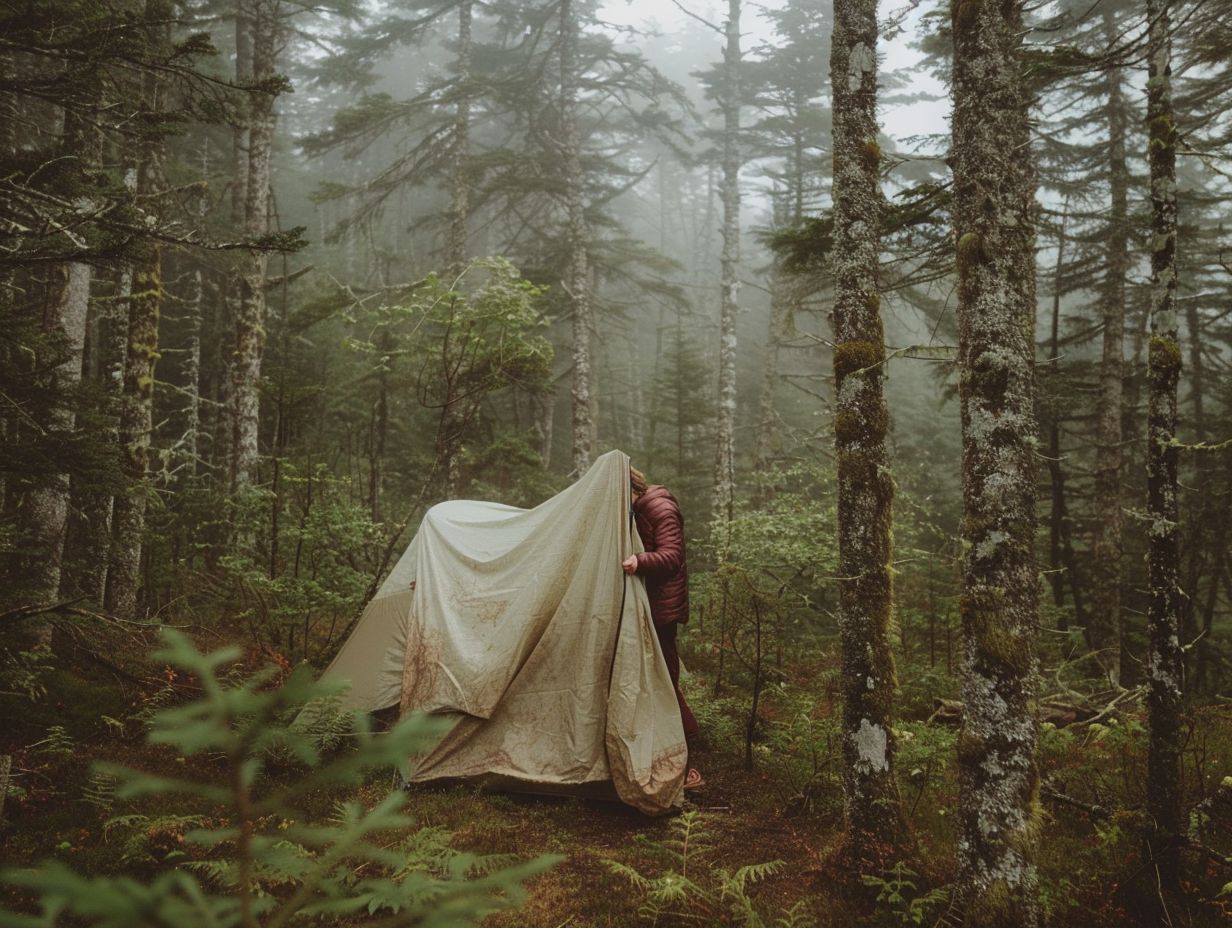
Ensuring safety and comfort during camping in windy conditions requires the use of high-quality equipment, wearing wind-resistant clothing, and regularly monitoring weather forecasts.
What Are Some Tips for Sleeping in Windy Conditions?
Recommendations for improving sleep quality in blustery conditions include utilising earplugs to minimise noise disturbance and ensuring that the tent is securely anchored to reduce movement.
Additionally, for an enhanced sleeping experience during blustery weather, it is advisable to consider investing in a high-quality sleeping bag specifically designed for lower temperatures. A well-insulated sleeping bag can effectively retain body heat, ensuring warmth throughout the night.
When setting up the tent, strategic placement is crucial. Positioning the tent behind natural wind barriers such as trees or large rocks can significantly diminish wind exposure, creating a more sheltered environment. Implementing these suggestions, in conjunction with other strategies, will contribute to a comfortable and restful night’s sleep despite the blustery conditions.
How to Protect Yourself from Windburn and Dehydration?
Ensuring protection against windburn and dehydration requires the implementation of certain measures, including the utilisation of protective clothing, application of moisturisers, and maintaining adequate hydration levels.
In instances of windy environments, the selection of attire crafted from wind-resistant materials is advisable, as it serves to shield the skin from the adverse effects of harsh weather conditions. The application of a generous layer of moisturiser prior to outdoor activities can establish a protective barrier against windburn.
It is essential to consistently reapply moisturiser throughout the day, particularly following exposure to wind or sun. Maintaining proper hydration levels is imperative in mitigating the risk of dehydration; therefore, it is recommended to carry a reusable water bottle and consume water regularly.
By prioritising these uncomplicated yet efficacious strategies, individuals can significantly contribute to the preservation of healthy skin and the prevention of dehydration in windy environments.
What Are Some Activities to Do During Windy Camping?
Recreational activities that can be enjoyed whilst camping in windy conditions include kite flying, windsurfing, and hiking in sheltered areas that offer protection from strong gusts. For individuals interested in kite flying, the windy weather presents an ideal opportunity to witness their vibrant kites soaring high in the sky effortlessly.
Windsurfing enthusiasts can capitalise on the robust gusts to elegantly glide across the water, experiencing the excitement of surfing the waves. In terms of hiking, selecting sheltered areas can help reduce the effects of the wind, facilitating a safer and more pleasant journey through the natural environment.
How to Pack Up and Leave a Campsite in Windy Conditions?
When faced with the task of leaving a campsite in windy conditions, it is crucial to engage in careful planning and use efficient packing techniques to ensure the securing of all equipment and the absence of any leftovers or signs upon departure.
What Are the Steps for Safely Packing Up Your Gear in Windy Conditions?
The procedure for safely packing gear in windy conditions involves several key steps. These include pre-organising items, utilising heavy-duty bags, and securing loose items to prevent them from being carried away by the wind.
It is essential to categorise gear based on weight and fragility during the packing process. Heavier items should be placed at the bottom of the bag to create a stable foundation. Fragile equipment must be wrapped in soft materials or positioned in padded compartments to prevent damage during transportation.
The use of compression straps or dividers within the bag can assist in keeping everything securely in place. To avoid any unintended spills or leaks, it is important to thoroughly check all closures and zippers.
It is important to note that a well-packed bag not only ensures the safety of the gear but also facilitates easy unpacking and access when required.
What Are Some Tips for Leaving No Trace in Windy Conditions?
Recommendations for minimising the impact of windy conditions involve adhering to certain guidelines, such as securing all items and waste, refraining from using lightweight materials susceptible to displacement, and conducting a thorough inspection of the camping area before departure.
It is imperative to utilise durable rubbish bags and receptacles to prevent objects from being carried off by the wind. When establishing the campsite, it is advisable to anchor down objects like tents, tarps, and cooking equipment using robust stakes or rocks.
Opting for reusable containers and dishes over disposable ones can diminish the risk of these items being dispersed by the wind. Furthermore, attentiveness towards loose items such as paper napkins, wrappers, or plastic bags is paramount, as they should be stored securely to prevent any littering of the environment.
Frequently Asked Questions
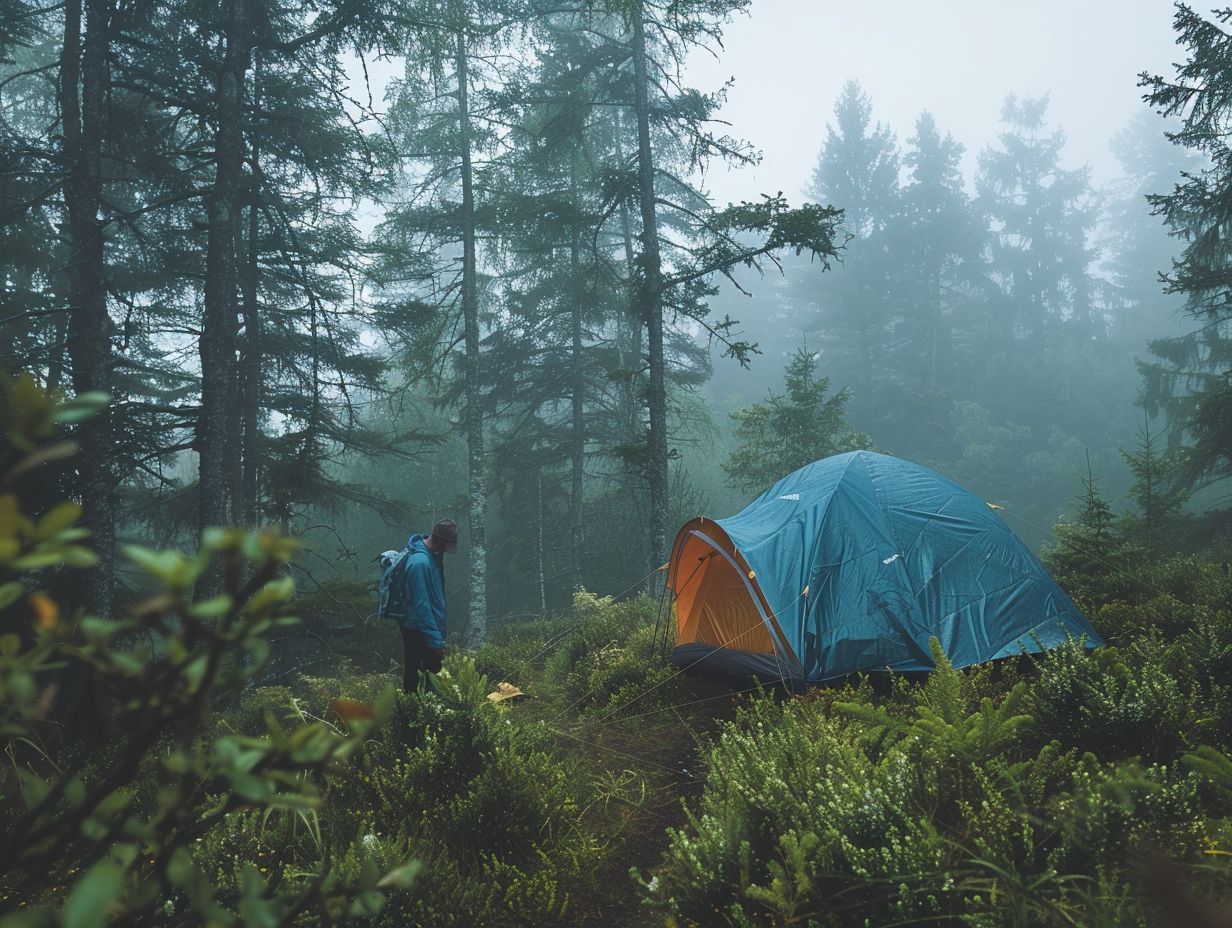
What are some important tips for camping in windy conditions?
Some important tips for camping in windy conditions include securing your tent properly, choosing a sheltered campsite, bringing wind-resistant gear, and being prepared for changing weather conditions.
How should I secure my tent in windy conditions?
It is important to properly secure your tent in windy conditions to prevent it from blowing away. This can be done by staking down all corners and using guylines to secure the poles. You can also use heavy rocks or sandbags to weigh down the tent.
What should I look for in a sheltered campsite?
When camping in windy conditions, it is important to choose a sheltered campsite to protect yourself and your gear. Look for natural barriers such as trees, rocks, or hills that can block the wind. Avoid setting up camp in open areas or on high ground where wind speeds can be stronger.
What kind of gear is best for camping in windy conditions?
When camping in windy conditions, it is best to bring wind-resistant gear such as a sturdy tent, a windproof jacket, and a tarp to protect your campsite. It is also helpful to bring extra tent stakes and guylines in case any break or get lost.
How can I stay safe in changing weather conditions while camping?
Weather conditions can change quickly when camping in windy conditions, so it is important to stay informed and be prepared. Check the weather forecast before your trip and bring appropriate clothing and gear. Be ready to adjust your plans or take shelter if necessary.
What should I do if I encounter strong winds while camping?
If you encounter strong winds while camping, it is important to stay calm and take precautions to protect yourself and your gear. Stay away from trees or other objects that could fall or be blown over. If necessary, seek shelter in a sturdy building or your car until the wind dies down.

